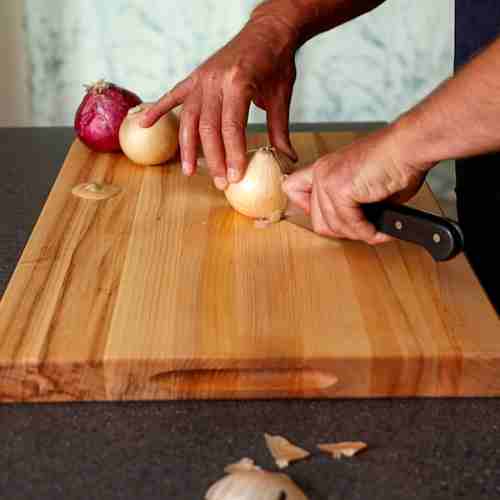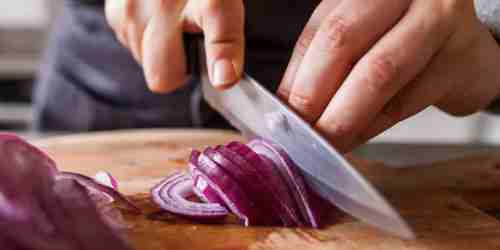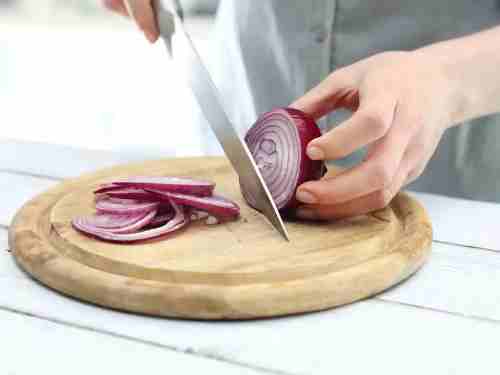Onions are the primary ingredient in a myriad of dishes. They can be used in the preparation of onions that have been fried or cut into pieces to make a component of a sofrito or mirepoix and add a flavour few other veggies can compete with. One drawback with onion rings… They can make us cry! Most of the time (if not all the time), the process of cutting onions results in tears. There are plenty of ways to help: Close your mouth, chew gum and even suggest wearing swimming glasses! If you’ve tried these methods previously, then you’re aware they’re not effective. What is the best way to cut the onion in a proper manner? We provide the best tear-free method to help all of you (with scientific evidence to support this!) for added value with the best tips for how to cut onions for various dishes.
Take care to trim the ends.
- Employ a chef’s knife with a good edge to trim the stem’s length approximately 1/2 inch.
- If you are cutting, trim beyond the root around 1/4-inch so that it is easy to cut through.
- If you are dicing, trim the roots of the bulb to get rid of the long strands, but leave the bulb in place, ensuring that the layers do not split. This is also a great method when cutting wedges.
Cut in half

The onion should be placed on the cutting board, stem side downwards. This will give the onion a flat, stable base to stand on. Slice lengthwise, beginning at the base and ending at the stem. This process is called “pole to pole.” The result is two parts.
Chef’s Tips: Put the sides that you cut down off the board to keep sulfur compounds. This will prevent you from having to tear your hair.
Peel off the skin
Utilize your fingers to remove the skin that is papery, starting at the stem’s edge. If you need to, peel off the initial layer of onion in order to facilitate peeling.
Slicing Onions Lengthwise vs Crosswise

If a recipe requires cut onions, there’s an option of how you cut them: lengthwise or crosswise.
If you’re cooking onions to caramelize, you’ll probably need to cut them in length in a row, from root to the stem. This will help them retain their shape longer when the process of cooking. The onions cut in a crosswise fashion tend to break apart once they are cooked. If you’re looking for what you want, then go for it.
Be aware that the pieces of onions are more stable during cooking when they’re cut from stem to root and are more likely to break after cooking if cut in a crosswise fashion.
If you’re adding raw onions to salad, cut them in half crosswise. It will be much easier to consume them, And they’ll look nice as well!
If you’re creating onion rings, be sure to slice the onion crosswise and also.
How do you cut off an onion in rings?

Remove the root portion by 1/4 inch. Trim the stem’s top end by 1/2 inch to make peeling the skin a little easier. Slice an additional 1/4-inch in the middle. Put the onion on the board, and cut the side towards the bottom to prevent it from slipping off. Hold the onion with firmness and cut it crosswise across the equator until you have rings with the desired size. Include them in sandwiches, burgers, Pickling, fried, or grilled onion rings.
Also, you can employ a mandoline for the making of rings. Make sure you are careful while holding the onion, as you do not want to slice your fingers on the blade.
How to Cut Onions Without Crying
There is a myriad of suggestions you can find on the Internet about how to prevent tears during the cutting of an onion. These range from using matches to placing the bread into your mouth. We’ve tried all theories available and found two of them that have worked for us.
Use a Really Sharp Knife
The initial method is simple: make use of a cutting knife that is sharp. It not only makes your work easier and easier, but it also bruises smaller onion cells, and the less tear-inducing enzyme is released.
Freeze the Onion
Another method is to put an onion into the freezer ten minutes prior to cutting. The freezing doesn’t affect the flavour or appearance of the onion; it just reduces the amount of enzyme released.
Tips for safety
Utilize a honed, sharp knife:
A dull knife is harder and riskier to cut. Make sure the knife is sharp when it’s dull. Utilize honing steel just before you begin to sharpen the knife. This will get the knife’s edges back towards the middle for sharp, precise cuts.
The best place to cut the blade:
The most efficient section of a chef’s knife is toward the centre, around 3 to 4 inches below the tip. Begin the vertical and horizontal cuts at the middle of the blade. Move all the way to the pointed tip to help cut more easily.
Protect your fingers:
Make use of your free hand to hold the onion in a claw-like grip to avoid cutting your fingers. The method involves inserting your fingers in such a way that your fingers are in line with the blade but not too close to the point that they touch. Your clawed hand moves just a bit further away from the area from the next cut when the blade begins to rise upwards for the next cut.
HOW TO STORE CUT ONIONS
- After being peeled, cut or cut, onions need to be kept refrigerated.
- The onions that are tightly wrapped with plastic wrap or inside the silicone bag may be stored in a refrigerator for seven or ten days.
- If you are planning to cut ahead and then freeze recipe portioned sizes containers of chopped and cut onions, be sure to eliminate all air from the bag. They should last for about six to eight months.